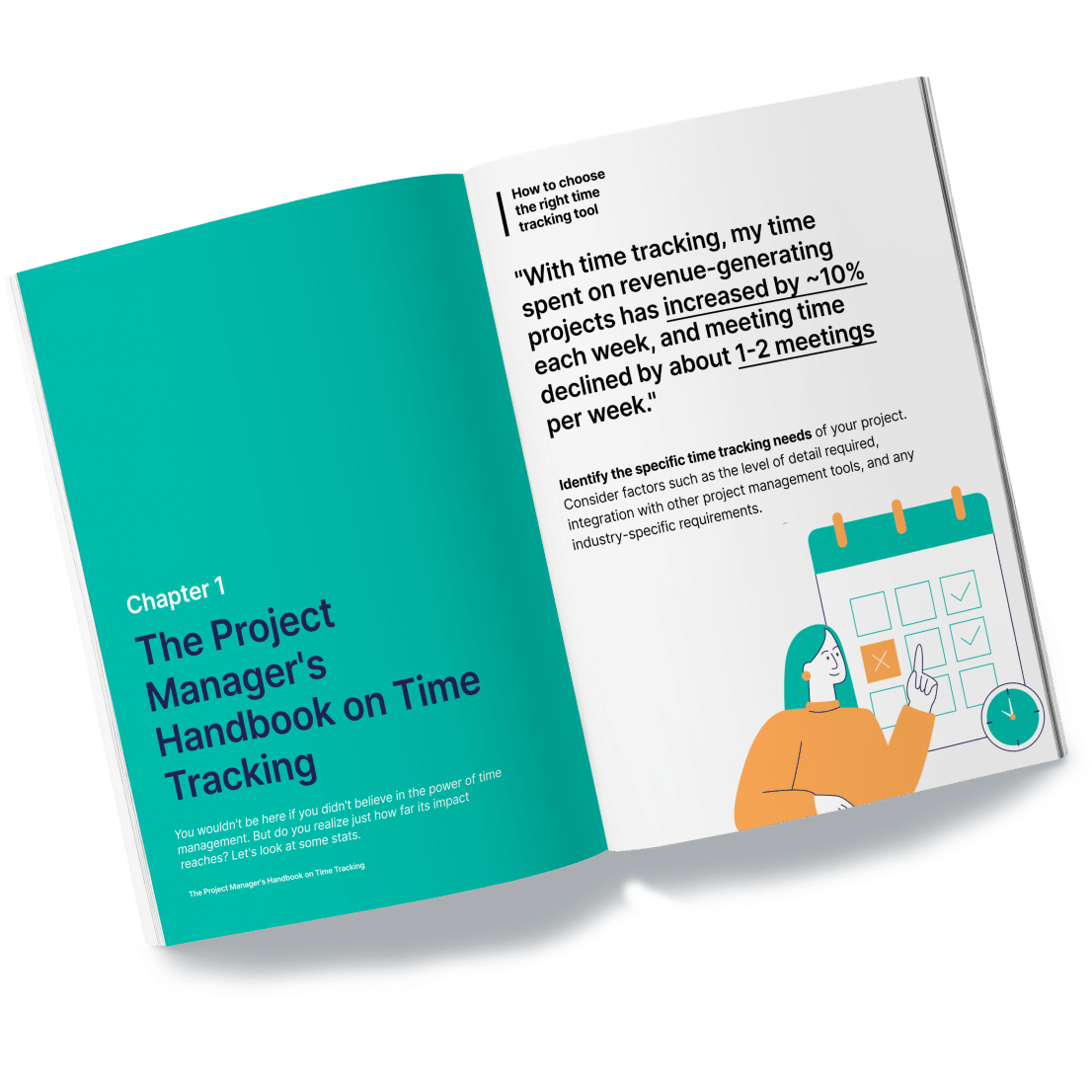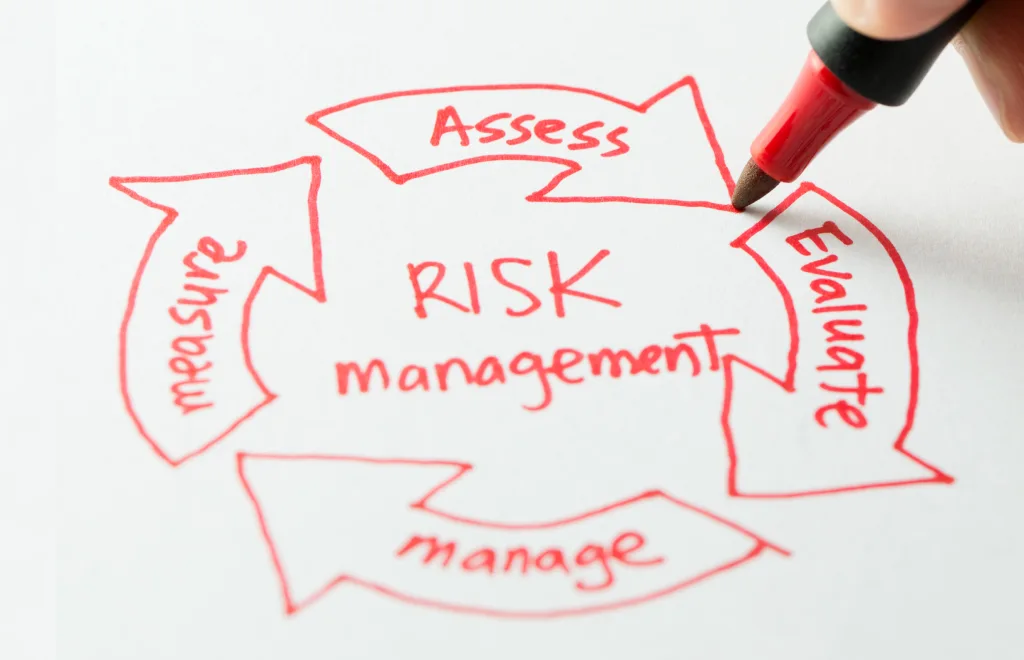Projekt-Risikomanagement: Der ultimative Leitfaden
Als Projektmanager haben Sie wahrscheinlich schon alles erlebt: Tage, an denen alles glatt läuft, an denen Ihr Projekt jeden Test besteht, die Produktivität Ihres Teams in die Höhe schießt und Ihre Kunden Sie mit Fünf-Sterne-Bewertungen überschütten.
Aber es gibt auch schwierige Tage, an denen es sich anfühlt, als würden Sie nur Brände löschen. Vielleicht verliert Ihr Projektteam den Überblick über den Umfang, oder die für eine wichtige Aufgabe zuständige Person ist krank.
Haben Sie schon einmal über eine Risikomanagementstrategie nachgedacht, mit der Sie endlich vermeiden können, in dieser Achterbahn der Höhen und Tiefen stecken zu bleiben?

Hole dir deine Schritt-für-Schritt-Anleitung für die Zeiterfassung als Projektmanager
Mit einem strukturierten Risikomanagementprozess warten Sie nicht nur darauf, dass Probleme auftauchen - Sie kommen ihnen zuvor. In diesem Artikel erfahren Sie, wie Sie Risiken identifizieren, kategorisieren und einen soliden Risikoreaktionsplan erstellen.
Was ist Risikomanagement bei Projekten?
Das Projektrisikomanagement ist ein wesentlicher Bestandteil des Projektmanagements und konzentriert sich auf die Identifizierung, Bewertung und Abschwächung von Risiken während des gesamten Projektlebenszyklus, um sicherzustellen, dass die Projektziele erreicht werden.
Am Anfang steht das Verständnis des "Projektrisikos" als das Potenzial für Ereignisse, die sich negativ auf das Projekt auswirken könnten. Der Prozess umfasst die Risikoermittlung (Feststellung, welche Risiken auftreten könnten), die Bewertung der Risikowahrscheinlichkeit (wie wahrscheinlich ihr Eintreten ist) und die Bewertung ihrer möglichen Auswirkungen.
Dieser Ansatz, der für ein effizientes Projektmanagement von zentraler Bedeutung ist, gewährleistet ein proaktives Risikomanagement. Als eine der Hauptaufgaben eines Projektmanagersist das Risikomanagement von entscheidender Bedeutung, um das Projekt reibungslos durch seinen Lebenszyklus zu steuern und die angestrebten Ziele zu erreichen.

Welches sind die häufigsten Projektrisiken?
Bei der Bewältigung von Projektrisiken werden Sie feststellen, dass diese unterschiedlich sind: intern, extern und technisch. Die Risiken, auf die Sie stoßen werden, hängen auch von der spezifischen Umgebung und der Dynamik Ihres Projektteams ab.
Das Project Management Institute (PMI) weist darauf hin, dass die Art der Risiken je nach Branche und den verwendeten Methoden sehr unterschiedlich sein kann.
Hinweis: Denken Sie daran, dass nicht alle Risiken schlechte Nachrichten sind. Es gibt auch "positive Risiken", die im Wesentlichen Chancen darstellen, die Ihrem Projekt zugute kommen können, wenn Sie Ihre Karten richtig ausspielen.
Ein wichtiger Teil Ihres Risikomanagementprozesses besteht darin, Projektrisiken zu ermitteln und nach Prioritäten zu ordnen. Das heißt, Sie müssen herausfinden, welche Risiken sofort behandelt werden müssen und welche warten können. Es geht darum sicherzustellen, dass Sie und Ihre Projektteammitglieder vorbereitet sind und das Projekt zum Erfolg führen können!
Hier finden Sie eine elementare Liste von Kategorien potenzieller Risiken im Projektmanagement:
Interne Risiken
Interne Projektrisiken sind heikle Probleme, die innerhalb Ihrer Organisation entstehen und die Sie vollständig kontrollieren können. Diese Risiken können auf jeder Ebene auftreten, einschließlich einer bestimmten Abteilung, des Projektteams oder des Projekts selbst.
Sehen wir uns einige typische Beispiele für interne Projektrisiken an:
- Es gibt ein Zeitplanrisiko, ein häufiges Problem, bei dem der Zeitplan Ihres Projekts durch interne Schluckaufs oder Fehler durcheinander gerät.
- Auch gesundheitliche Risiken innerhalb Ihres Teams, wie z. B. die Erkrankung von Projektmitarbeitern oder ein Burnout, können Ihre Fortschritte zunichte machen.
- Kostenrisiken sind ein weiterer wichtiger Faktor. Hier geht es um die finanzielle Seite, d. h. darum, dass Sie am Ende vielleicht mehr ausgeben als geplant oder Ihr Budget nicht effizient einsetzen.
Hier kommen die Fähigkeiten Ihres Projektteams im Umgang mit Risikoereignissen zum Tragen. Mit einem soliden Risikomanagementplan für das Projekt können Sie diese möglichen Risiken erkennen, bevor sie sich zu größeren Problemen entwickeln.
Es geht darum, Risiken frühzeitig zu erkennen, ihre potenziellen Auswirkungen zu verstehen und Risikomanagementstrategien zu entwickeln, um sie in Schach zu halten.
Und wenn doch ein Risiko auftaucht? Wenn Sie über einen Plan zur Risikominderung und -bewältigung verfügen, können Sie das Risiko direkt angehen und sicherstellen, dass Ihr Projekt wie geplant voranschreitet.
Erfahren Sie, wie Sie mit Hilfe von Zeitschätzungen interne Risiken im Projektmanagement reduzieren können.
Externe Risiken
Externe Projektrisiken sind solche, die von außen auf Ihr Unternehmen zukommen und sich der Kontrolle Ihres Teams völlig entziehen. Betrachten Sie sie als Herausforderungen, die weder Projektmanager noch Projektbeteiligte direkt beeinflussen können.
Ein paar Beispiele?
- Änderungen in der Regierungspolitik
- Veränderungen der Umwelt
- Große wirtschaftliche Umwälzungen
Nehmen wir die Covid-19-Pandemie - sie war eine massive globale Gesundheitskrise, der kein Projekt ausweichen konnte. Sie stürzte die Lieferketten ins Chaos, brachte den internationalen Handel durcheinander und erschütterte sogar die Arbeitskräfte und die technischen Hilfsmittel, auf die Unternehmen angewiesen sind.
Für die Projektmanager bedeutet dies, dass sie während des Planungsprozesses ein wachsames Auge auf die Welt da draußen haben müssen. Es geht nicht nur darum, einen Weg zum erfolgreichen Projektabschluss zu finden, sondern auch um eine solide Strategie zur Risikoüberwachung.
Auf diese Weise werden Sie nicht überrascht, wenn etwas Unerwartetes auftaucht, und können Ihre Projekte verwalten und Ihre Pläne entsprechend anpassen.
Lesen Sie auch: Projektmanagement-Berichte

Technische Risiken
Im Projektmanagement können technische Risiken bei verschiedenen Arten von Projekten auftreten. Diese Risiken hängen mit den technischen Ressourcen zusammen, die Sie einsetzen.
Das bedeutet, dass Sie sich mit potenziellen Softwareproblemen, Hardwarefehlfunktionen, Störungen im digitalen Netzwerk oder Problemen mit Ihren digitalen Ressourcen auseinandersetzen müssen. Gleichzeitig gibt es Herausforderungen wie Bedrohungen der Cybersicherheit, das Schritthalten mit neuen Technologien und die Anpassung an sich ändernde gesetzliche Anforderungen.
Die Bewältigung dieser potenziellen Risiken ist ein wichtiger Bestandteil des Risikomanagementprozesses Ihres Projekts. Es geht darum, für alle technischen Probleme gewappnet zu sein, sei es eine wackelige Internetverbindung oder eine Computerstörung.
PM-Risiken
Es geht darum, die Herausforderungen des Projektmanagements zu meistern, von der Verbesserung Ihrer Projektmanagementfähigkeiten bis hin zur Zeiteinschätzung und der Einhaltung des Projektbudgets.
Wichtige Instrumente wie ein Risikoregister und eine quantitative Risikoanalyse sollten in Betracht gezogen werden. Sie helfen Ihnen, potenzielle Probleme frühzeitig zu erkennen und ihre Auswirkungen zu messen, damit Sie und Ihre wichtigsten Interessengruppen auf dem Laufenden bleiben.
Der Umgang mit diesen potenziellen Projektrisiken hilft Ihnen nicht nur, Ihre Projektziele zu erreichen, sondern schärft auch Ihre Fähigkeit, zukünftige Projekte zu verbessern, und erhöht die Risikotoleranz Ihres Teams.
Und denken Sie daran, dass Sie manchmal ein Tigerteam kann in schwierigen Situationen ein echter Wendepunkt sein.
Ein Tigerteam könnte die Lösung sein, die Sie brauchen, um ein Problem in Ihrem Projekt zu lösen.
TIPP: Erfahren Sie in unserem Leitfaden zur Projektverfolgung, wie Sie Risiken verfolgen und verwalten können.

Hole dir deine Schritt-für-Schritt-Anleitung für die Zeiterfassung als Projektmanager
Beispiele für Risiken im Projektmanagement
Unerwartete Risiken sind fast unvermeidlich. Um die angestrebten Projektergebnisse zu erzielen, ist ein wirksamer Plan für das Risikomanagement von größter Bedeutung.
Auf diese Weise fühlen sich die Projektmanager sicherer im Umgang mit Risiken in verschiedenen Szenarien. Sehen Sie sich einige der häufigsten Risiken an:
- Hohe Kosten - manchmal überschreiten Projekte das Budget, was auf unrealistische Budgetierung im Projektplanungsprozess zurückzuführen sein kann. Eine Budgetüberschreitung kann auch bei einem perfekten Plan vorkommen, aber es ist am besten, alle möglichen Kosten und die Auswirkungen des Kostenrisikos auf das Projekt detailliert darzustellen.
- Ungenügende Leistung - die Ursache dafür ist meist schwer zu ermitteln. Mit einer gründlichen Risikoermittlung können Sie jedoch potenzielle Risiken (Kommunikationsfehler, Burnout, Überstunden usw.) in den Griff bekommen.
- Terminprobleme - in jedem Projektplan gibt es Puffer, die Verzögerungen zulassen. Mit einem anfänglichen Plan zur Risikobewertung und den richtigen Instrumenten, wie z. B. einem Tool zur Zeiterfassung, können die Projektleiter jedoch Verzögerungen bei den Liefertagen und anderen Faktoren verhindern.
- Ressourcenmangel - Ressourcen können Zeit, Geld, Werkzeuge und Menschen sein. Die Projektleiter sind dafür verantwortlich, die Ressourcen zu sichern und sich über alle Risikoereignisse auf dem Laufenden zu halten, die ihre Ressourcen beanspruchen und den Erfolg des Projekts verhindern.
- Operative Aspekte - ein operatives Risiko entsteht, wenn die Projektmanagement-Software geändert wird oder sich die Rollen im Management oder im Team ändern. Zu dieser Kategorie gehört auch die Einführung neuer Verfahren.

Management von Projektrisiken in 6 Schritten
Der beste Weg, das Risikomanagement anzugehen, ist, einfach einen Risikomanagementplan zu erstellen und das gesamte Team, ihn zu befolgen:
Im Folgenden werden die grundlegenden Schritte eines Risikomanagementplans für ein Projekt beschrieben:
1. Identifizieren Sie die Art des Risikos und die Umstände
Um ein Problem zu lösen, müssen Sie es identifizieren. Danach sollten Sie es in Ihr Risikoregister aufnehmen und so viele Daten wie möglich über den Kontext sammeln.
Beziehen Sie Ihr Team ein, um die ermittelten Risiken zu erörtern und Lösungen für sie zu finden.

2. Analysieren Sie das Risiko
Sobald Sie alle Daten gesammelt haben (was ein kontinuierlicher Prozess sein kann), müssen Sie eine Risikoanalyse der einzelnen Risikoereignisse durchführen.
A gute Projektmanagementsoftware hilft bei der Risikoanalyse. Wenn Sie keine haben, verfügen Sie vielleicht schon über einen internen Rahmen für das Risikomanagement in Ihrem Unternehmen.
Durch eine gründliche qualitative und quantitative Analyse Ihrer Daten sind Sie in der Lage, unabhängig von der Art des Projekts das Auftreten von Risiken zu verhindern.
3. Prioritäten setzen, was wichtig ist
Unterschiedliche Risiken haben unterschiedlich starke Auswirkungen. Nachdem Sie Ihre Risiken analysiert haben, kategorisieren Sie nun jedes Risikoereignis in die Kategorien hoch, mittel oder gering.
Auf diese Weise können Sie einen wirksamen Risikomanagementplan erstellen, da Sie wissen, welche Risiken sofortige Maßnahmen erfordern und welche aufgeschoben werden können.
Lesen Sie auch: Die besten Tools zur Priorisierung der Arbeit
4. Zuweisung eines Risikoverantwortlichen
Jedes ermittelte Risiko sollte einer Person zugewiesen werden, die die Arbeit zu seiner Lösung leitet.
Der Projektleiter ist für die Auswahl eines geeigneten Kandidaten verantwortlich, wobei er dessen Fähigkeiten, Erfahrung und Fachwissen berücksichtigt.
5. Erstellen Sie einen Reaktionsplan
Jetzt ist es an der Zeit, den Risikoreaktionsplan in die Praxis umzusetzen. Denken Sie bei der Erstellung Ihres Reaktionsplans daran, dass Sie auch an andere positive Auswirkungen denken können. Jedes Problem mit Ihrem Risikoregister kann auch unerwartete Vorteile mit sich bringen. Bleiben Sie kreativ!
Von dort aus handeln der Manager und der Risikoeigner gemäß dem entwickelten Risikomanagementplan.

6. Überwachen Sie das Risiko
In dieser Phase muss die verantwortliche Person den Manager durch Anrufe oder E-Mails auf dem Laufenden halten, um ein genaues Bild vom Gesamtfortschritt des Projekts und von etwaigen Änderungen im Risikomanagementplan zu erhalten.
Lesen Sie auch: Die Bedeutung und die Vorteile der Projektüberwachung
Was sind die Herausforderungen beim Risikomanagement von Projekten?
Das Management von Projektrisiken ist eine Herausforderung. Wie bereits erwähnt, hängen die Herausforderungen von vielen Faktoren ab, unter anderem von der Art des Projekts und den damit verbundenen Risiken, unabhängig davon, ob diese bereits ermittelt wurden oder nicht. Hier sind einige:
- Schwierigkeiten bei der korrekten Ermittlung der Projektrisiken - dies kann aufgrund mangelnder Zusammenarbeit oder mangelnden Engagements bei der Ermittlung von Risiken geschehen.
- Bearbeitung zu vieler Projekte gleichzeitig - ein Projekt erfordert bereits die Beachtung jedes einzelnen Risikos und jedes einzelnen Plans zur Risikominderung, mehrere Projekte gleichzeitig erhöhen die Komplexität. Selbst die besten Projektmanagementfähigkeiten können in diesem Fall überfordert sein.
- Der Risikomanagementplan wird ignoriert - er wurde zwar entwickelt und ist im Risikoregister enthalten, aber er wird nicht beachtet oder umgesetzt.
TIPP: Lesen Sie unseren Blog und erfahren Sie , wie Sie mehrere Projekte gleichzeitig verwalten können.

Automatisieren Sie die Zeiterfassung mit Timeular und erledigen Sie sie in weniger als 1 Minute pro Tag
Wie Sie Risiken abmildern können
Die Abschwächung von Risiken beruht in erster Linie auf deren Vorwegnahme und Planung. Wenn man sich die besprochenen Beispiele ansieht, wird klar, dass jedes von ihnen eine Planung für den schlimmsten Fall, die Vorwegnahme neuer Risiken, die Erstellung alternativer Pläne und die genaue Einhaltung aller dieser Pläne erfordert.
Darüber hinaus können wir fünf Strategien zur Risikominderung auflisten, die bei der Planung der Risikominderung helfen:
- Akzeptieren - Bei der Akzeptanz des Risikos werden die Folgen der einzelnen Risikoereignisse analysiert, um festzustellen, welche davon akzeptabel sind. Was kann getan werden, um das Problem zu lösen, und welche Teammitglieder können dazu beitragen, es zu mindern?
- Vermeiden - Bei der Risikovermeidung überlegen die Teammitglieder, wie sie die Möglichkeit, dass das Risiko eintritt, vermeiden können. Das Ziel ist es, einen Plan für ein hypothetisches Risiko zu erstellen und eine präventive Haltung einzunehmen, um es zu vermeiden.
- Kontrolle - Wenn das Risiko nicht vermieden werden kann, muss es kontrolliert werden. Welche Maßnahmen müssen ergriffen werden, um die Auswirkungen des Risikos zu kontrollieren?
- Übertragung - Bei dieser Strategie wird die Verantwortung für das Risiko und seine Folgen auf eine andere Partei, z. B. eine Versicherung, übertragen.
- Überwachen - Es ist von entscheidender Bedeutung, alle Risiken zu überwachen, um Änderungen während der Laufzeit eines Projekts zu verstehen. Die Teammitglieder müssen die Verantwortung für die Überwachung von Risiken, neuen Risiken und Projektänderungen übernehmen.
Lesen Sie unseren Artikel und erfahren Sie, warum eine Checkliste für das Projektmanagement die Risiken minimiert.
FAQs
Was ist ein Risikomanagementplan?
Ein Projektmanagement-Risikoplan beschreibt, wie der Risikomanagementprozess eines Projekts durchgeführt wird. In diesem Dokument wird festgelegt, wie das Risikomanagement angegangen werden soll, wie die mit dem Projekt verbundenen Risiken am besten zu verstehen und zu bewältigen sind und welche Verantwortlichkeiten die einzelnen Teammitglieder bei der Bewältigung der ermittelten Risiken haben.
Was sind die Schritte des Projektrisikomanagements?
Die Schritte des Projektrisikomanagementprozesses sind Identifizierung, Analyse, Prioritätensetzung, Eigenverantwortung, Reaktion und Überwachung.
Welches sind die besten Instrumente für das Risikomanagement?
Die wesentlichen Instrumente zur Unterstützung Ihres Risikomanagementplans finden Sie in Ihrem Projektmanagement-Tool oder ganz einfach online: Marketinganalysen, Budgetverfolgung, ein Risikoregister oder gemeinsame Brainstorming-Sitzungen.
Darüber hinaus kann ein Qualitätsbewertungs- und Risikoanalyseprozess oder die Erstellung einer Wahrscheinlichkeitsmatrix und die Durchführung einer guten Ursachenanalyse zum Projekterfolg führen.
Wie lautet die Formel für die Risikomatrix?
A Risikomatrix wird zur Risikobewertung verwendet. Eine ihrer Achsen dient zur Bestimmung der Wahrscheinlichkeit eines Risikos, die andere zur Bestimmung der Folgen oder des Schweregrads. Das Risiko ist also gleich Wahrscheinlichkeit mal Schweregrad.
Schlussfolgerung
Ein Plan für das Risikomanagement eines Projekts kann die Unvorhersehbarkeit potenzieller Projektrisiken eindämmen und Ihr Projekt auf einem stabileren Kurs halten.
Auch wenn es nicht möglich ist, Risiken auszuschalten, da sie außerhalb Ihres Einflussbereichs liegen, ist es von größter Bedeutung, in jeder Projektphase Risikomanagement- und Risikominderungspläne zu erstellen.
Damit dies gelingt, müssen alle Beteiligten, von der Führungskraft über die Mitarbeiter bis hin zur Verwaltung des Unternehmens, in der Anwendung verschiedener Risikomanagementverfahren geschult werden.